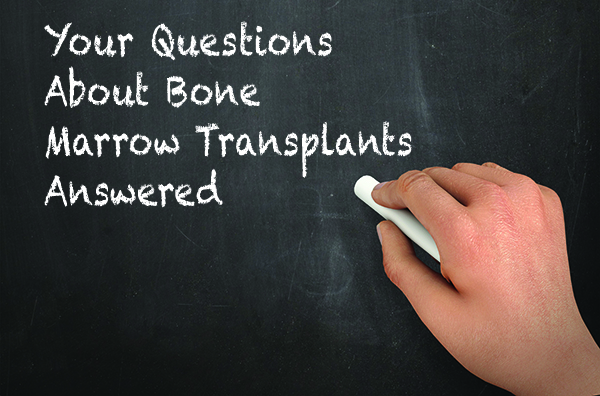Your Questions About Bone Marrow Transplants Answered
A blood or bone marrow transplant is a treatment option for people with a blood cancer, such as leukemia or lymphoma, or a blood disorder, like sickle cell disease. Here are answers to some of the most common questions about bone marrow transplants.
How does a blood or marrow transplant work?
A blood or marrow transplant replaces unhealthy blood-forming cells with healthy ones. Blood-forming cells are immature cells that grow into red blood cells, white blood cells, and platelets. They’re found in the soft tissue inside your bones, called bone marrow. When they’re mature, they leave the marrow and enter the bloodstream.
Before transplant, you get chemotherapy and sometimes radiation to destroy the diseased cells and marrow. Then, the healthy cells are given to you.
Bone marrow transplant is not surgery. The new cells go into your bloodstream through an intravenous catheter or tube. It’s just like getting blood or medicine through an IV. From there, the cells find their way into your marrow. It can take months or years to recover from a blood or marrow transplant.
Where do the healthy cells come from?
Healthy blood-forming cells used in transplant can come from three sources:
- Bone marrow – spongy tissue inside of bones
- Peripheral blood stem cells – blood-forming cells from the circulating blood
- Cord blood – the blood collected from the umbilical cord and placenta after a baby is born
It takes time to plan for a transplant, so your doctor may start the process early – even if you are still considering other treatments.
What are the different types of bone marrow transplant?
There are two main types of transplant:
- An autologous transplant uses your own blood-forming cells.
- An allogeneic transplant uses blood-forming cells donated by someone else. The cells can come from a family member. This could be someone with closely matched human leukocyte antigens, like a sibling. Or this could be someone who matches half of your HLA, like a parent or child. The cells can also come from an unrelated adult donor or cord blood unit through the Be The Match® Registry.
Other Names for Bone Marrow Transplant
You might hear blood or bone marrow transplants called:
- Allo (allogeneic) transplant
- Auto (autologous) transplant
- BMT – bone marrow transplant
- Haplo – haploidentical, or half- matched, transplant
- HCT – hematopoietic cell transplant
- SCT – stem cell transplant
Which type of transplant is best for me?
Your transplant doctor will tell you which type of transplant and which source of cells is best for you. This decision is based on many factors, including what disease you have and its stage, as well as your overall health.
When is the best time to have a transplant?
It takes time to plan for a transplant, so your doctor may start the process early – even if you are still considering other treatments. In general, transplants are most successful if:
- The disease is in an early stage
- You are in remission, or there is very little disease in your body
- Your disease has gotten better after treatment
- You are in good overall health
What can I expect during recovery?
Recovering from a transplant takes time. Some complications are common. Your doctor can help you understand possible complications and treatments to help reduce them. You will stay in or near the hospital during early recovery. The following are and helpful tips to support your recovery:
- Managing your medicines You may have to take a lot of medicine after transplant. It’s extremely important to take your medicines exactly as your doctor tells you to.
- Food safety Good nutrition is important for gaining strength and health after transplant. But, because your immune system is still working to get stronger, some foods and drinks could put you at a higher risk for infection. That’s why it’s important to follow your transplant team’s advice on how to safely choose, prepare, and handle food. Your dietitian can help you create recipes that are best for you.
- Graft-versus-host disease GVHD is a common, and sometimes serious, side effect of an allogeneic transplant. There’s no guaranteed way to prevent GVHD, but there are ways to lower your risk. Don’t ignore the early signs or symptoms of GVHD. If GVHD is caught early, treatments may work better. GVHD is serious, but there is treatment. Talk with your doctor about a treatment plan for you.
After your transplant, it’s important that you continue to have checkups with your healthcare team – whether it’s with your transplant team, your hematologist or oncologist, or your primary care doctor. Even if you’re feeling well, your checkups are important to staying healthy.
Be The Match® has a team dedicated to providing information and support to you before, during, and after transplant. You can call (888) 999-6743 or visit BeTheMatch.org.one-on-one to ask questions you may have about transplant, request professional or peer support, or receive patient education materials. All programs and resources are free.
Source: Be The Match, BeTheMatch.org
This article was published in Coping® with Cancer magazine, January/February 2022.


